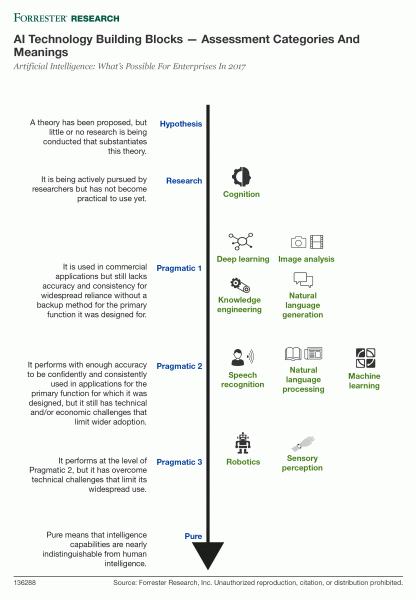Artificial Intelligence: Fact, Fiction. How Enterprises Can Crush It
Forrester surveyed business and technology professionals and found that 58% of them are researching AI, but only 12% are using AI systems. This gap reflects growing interest in AI, but little actual use at this time. We expect enterprise interest in, and use of, AI to increase as software vendors roll out AI platforms and build AI capabilities into applications. Enterprises that plan to invest in AI expect to improve customer experiences, improve products and services, and disrupt their industry with new business models.
But the burning question is: how can your enterprise use AI today to crush it? To answer this question we first must bring clarity to the nebulous definition of AI. Let’s break it down further:
- “Artificial” is the opposite of organic. Artificial simply means person-made versus occurring naturally in the universe. Computer scientists, engineers, and developers research, design, and create a combination of software, computers, and machine to manifest AI technology.
- “Intelligence” is in the eye of the beholder. Philosophers will have job security for a very long time trying to define intelligence precisely. That’s because, intelligence is much tougher to define because we humans routinely assign intelligence to all matter of things including well-trained dachshunds, self-driving cars, and “intelligent” assistants such as Amazon Echo. Intelligence is relative. For AI purists, intelligence is more akin to human abilities. It means the ability to perceive its environment, take actions that satisfy a set of goals, and learn from both successes and failures. Intelligence among humans varies greatly and so too does it vary among AI systems.
Temper Your Expectations, But Don’t Give Up On AI
AI has been oft overhyped, including in 1967 when Marvin Minsky, a pioneer in the field of artificial intelligence and cofounder of the Massachusetts Institute of Technology’s AI laboratory, stated that “within a generation the problem of creating ‘artificial intelligence’ will substantially be solved.” He was wrong, but not entirely:
- Humanity is still far away from pure AI . . . The highest benchmark for AI is the humanlike abilities to perceive (sense), learn, think (formulate ideas), interact, and take actions. This is pure AI. We aren’t there yet, although forms of pure AI have been imagined in science fiction such as Ex Machina (humanoid robot), The Matrix (large computer), and Star Wars (various robots). AI doesn’t have to take human form or any form at all (but, it is awesome when it does such as in HBO’s “WestWorld”). It can be just software. Some AI researchers envision AI that could ultimately exceed human intelligence, an idea also commonly explored in science fiction.
- . . . but pragmatic AI can have transformative value today. AI is not one universal technology. Rather, it is composed of technology building blocks that, individually or in combination, are advanced enough to add a modicum intelligence to applications that can lead to significant business transformation. This is pragmatic AI. The state of the art in pragmatic AI is bright glimmers of intelligence that is advanced enough for enterprises to exploit now. For example, enterprises use machine learning — a pragmatic AI building block — to build predictive models and natural language processing (NLP) to analyze customer interactions. Developers can leverage those AI technology building blocks to add a modicum of intelligence to applications that dramatically boost their ability to learn and adapt from data.
It’s All About Nine AI Building Block Technologies
Internet giants and digital natives such as Airbnb, Alibaba, Amazon, Apple, Facebook, Google, Netflix, Uber, and others use AI technology building blocks to build billion-dollar empires. Google CEO Sundar Pichai describes AI as “a core, transformative way by which we’re rethinking how we’re doing everything.” Apple CEO Tim Cook concurs, saying that “AI will make this product [the iPhone] even more essential to you [the customer].” These technology behemoths are no longer alone. Software giants (such as IBM, HP Enterprise, Microsoft, Oracle, Salesforce, and SAS), startups (such as Artificial Solutions), and open source projects (such as TensorFlow and Apache SystemML) offer AI tools, platforms, and/or solutions for enterprise consumption. Enterprises, inspired by these technology giants, want to create scalable, individualized customer experiences and look to build their own AI capabilities with help from enterprise software vendors and open source solutions.
To understand how AI can help enterprises, AD&D pros have to understand the maturity and scope of AI building blocks and how they can infuse applications and business processes with intelligence. AI building blocks range from technologies that haven’t made it out of the lab to pragmatic technologies that can be used right now.
Forrester clients can read the full report Artificial Intelligence: What’s Possible For Enterprises In 2017.

